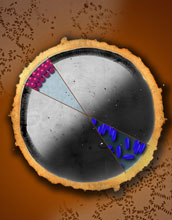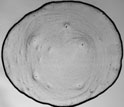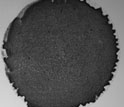News Release 11-166
The Future of Inks, Paints and Coatings Takes Shape
Researchers determine that particle shape affects the 'coffee ring effect'

The shape of particles in a drop of liquid plays a role in the "coffee ring effect."
August 17, 2011
View a video showing the role of particle shape in the "coffee ring effect."
This material is available primarily for archival purposes. Telephone numbers or other contact information may be out of date; please see current contact information at media contacts.
If you've ever spilled a drop of coffee on a surface, you might have noticed the curious way the color concentrates at the edges when the coffee dries. This is known as the "coffee ring effect," and recently, researchers have determined that the shape of the particles in the liquid is an important factor in creating this pattern. The research results could eventually translate into new techniques or formulations for product coatings, or better inks and paints.
This work, published in the August 18 issue of the journal Nature was performed by Arjun Yodh and colleagues at the University of Pennsylvania.
"We found that if you change the shape of the particles in the solution, the coffee ring effect goes away, and you end up with a uniform coating," said Peter Yunker, a graduate student in Yodh's lab.
First, a little fluid dynamics: As the liquid in a droplet evaporates, the edges remain fixed, so as the volume decreases, fluid flows outward from the middle of the droplet to its edges. This flow carries particles to the edges, and round particles at the edge will pack closely. By the time all of the liquid in the droplet evaporates, most of the particles will be at the edge, producing the coffee ring effect.
Both the shape that liquid droplets take, and the way the shape changes as the droplets evaporate, is greatly influenced by surface tension at the air-liquid interface. This tension is a property of the interface, based on how the molecules in the liquid interact with one another versus the air. For example, liquids with a high surface tension, like water, may form a raised droplet, because the molecules are very attracted to one another and not so attracted to the air. In contrast, liquids with lower surface tension, like alcohols, are more likely to form flat spots instead of curved droplets.
The Yodh group found that elongated particles in a liquid behave differently than round ones because of the way they are affected by the surface tension of the air-liquid interface. The forces at work are even observable in a common breakfast cereal.
"If you make the particles elongated or ellipsoidal, they deform the air-water interface, which causes the particles to strongly attract one another. You can observe this effect in a bowl of cheerios-if there are only a few left they clump together in the middle of the bowl, due to the surface tension of the milk," explained Yunker.
This clumping changes the way the particles distribute themselves within the droplet. Even if the clumped ellipsoidal particles reach the edge of the droplet, they do not pack as closely as round particles. The loosely packed clumps eventually spread to cover the entire surface, filling it so an even coating of particles is deposited when evaporation is complete.
"This work gives us a new idea about how to make a uniform coating, relatively simply. If you change the particle shape, you can change the way a particle is deposited. You can also make mixtures. In some cases, even just a small amount of ellipsoids can change the way the particles deposit when they dry," said Yodh.
In future studies, the research team will explore drying and deposition of different types of fluids. They will also investigate different particle sizes and shapes, and the interplay of particle mixtures.
"This is an exciting scientific result with potential commercial applications, which was in part enabled by support of the Materials Research Science and Engineering Center at the University of Pennsylvania," said Mary Galvin, program director for the division of materials research at the National Science Foundation, which partially funded the research. The centers program, recently renamed Materials Research Centers and Teams, provides support for interdisciplinary materials research and education while addressing fundamental problems in science and engineering.
-NSF-
-
View Video
View a video that explains how particle shape plays a role in the "coffee ring effect."
Credit and Larger Version -
When a drop of coffee dries, the round particles concentrate at the edges of the dried drop.
Credit and Larger Version -
If a drop contains elongated particles they spread to cover the entire surface of a dried droplet.
Credit and Larger Version
Media Contacts
Lisa Van Pay, NSF, (703) 292-8796, email: lvanpay@nsf.gov
Evan Lerner, University of Pennsylvania, (215) 573-6604, email: elerner@upenn.edu
Program Contacts
Mary E. Galvin, NSF, (703) 292-8562, email: mgalvind@nsf.gov
Principal Investigators
Arjun Yodh, University of Pennsylvania, (215) 898-8571, email: yodh@physics.upenn.edu
The U.S. National Science Foundation propels the nation forward by advancing fundamental research in all fields of science and engineering. NSF supports research and people by providing facilities, instruments and funding to support their ingenuity and sustain the U.S. as a global leader in research and innovation. With a fiscal year 2023 budget of $9.5 billion, NSF funds reach all 50 states through grants to nearly 2,000 colleges, universities and institutions. Each year, NSF receives more than 40,000 competitive proposals and makes about 11,000 new awards. Those awards include support for cooperative research with industry, Arctic and Antarctic research and operations, and U.S. participation in international scientific efforts.
Connect with us online
NSF website: nsf.gov
NSF News: nsf.gov/news
For News Media: nsf.gov/news/newsroom
Statistics: nsf.gov/statistics/
Awards database: nsf.gov/awardsearch/
Follow us on social
Twitter: twitter.com/NSF
Facebook: facebook.com/US.NSF
Instagram: instagram.com/nsfgov



